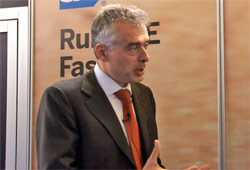At the LTE World Summit 2013 held in Amsterdam last month, mobile operators and vendors gathered to discuss and highlight the latest trends and issues affecting 4G LTE networks.
To date, there are 194 commercial LTE networks live in 75 countries, and 443 operators are currently investing in 4G LTE in 130 countries, according to the Global Mobile Suppliers Association (GSA).
As more operators continue to roll out 4G services this year and engage in trial of new services, new challenges are surfacing, which were brought up during the various presentations and panels during the three-day event.
KPN’s Chief Strategy, Innovation & Technology Officer Erik Hoving highlighted the fact that there are now 150 points of access to an operator’s network every day from a subscriber’s smartphoner, and how that presents new entrepreneurial opportunities that can be used in conjunction with LTE.
Tele2’s CSO Roxanna Zea echoed the need for partnerships, particularly in providing premium on-demand content services as a differentiator, which was also the view of SK Telecom’s CTO Dr Jae W Byun.
LTE roaming was also brought up as a significant challenge affecting operators, especially the need to manage an increase in Diameter Signalling, according to Victoria Nikiforova Foley, LTE Business Development Manager, Vodafone Roaming Services.
Meanwhile, Telia Sonera’s Tommy Ljunggren, Vice President, System Development at Mobility Services, pointed to the need for handsets and frequency bands between countries to be compatible in order for 4G LTE services to truly work.
When it came to the vendors, SAP’s Michel Van Veen, IPX Business Manager for SAP Mobile Services saw LTE as “not just a set of standards, [but] a reality”, highlighting the need for operators to step up and use IPX to solve roaming challenges.
Sameh Yamany, President and CEO of Trendium agrees that LTE is now a cornerstone for new services, and emphasized the need to use policy management not just to manage subscriber billing, but also to manage the network, using a “real-time context awareness”.
Manish Singh, CTO of Radisys focused on the need for end-to-end solutions and how LTE small cells can enable HetNets While MRF assists with VoLTE and RCS services.
Intel’s Stefan Wolff, VP for Intel’s Mobile and Communications Group, spoke about how Intel’s chipsets are becoming more prevalent in LTE-enabled devices, particularly the new multi-mode data and voice device which supports 15 spectrum bands simultaneously.
Eric Carr, VP and General Manager, Mobile for Guavus, stressed the need for an “optimised data stack” when it comes to big data analytics, in order to help operators to solve many types of problems at the same time.
Jonas Petersson, the Senior Technical Advisor for Polystar, also focused on the need for big data, particularly Deep Packet Inspection and enriching the data feed with additional value to help operators know what subscribers are doing and how to improve application coverage.
To view the in-depth video interviews Mobile Europe conducted at LTE World Summit 2013, click the links below:
Guavus
Intel
Polystar
RadiSys
SAP Mobile Services
Trendium


